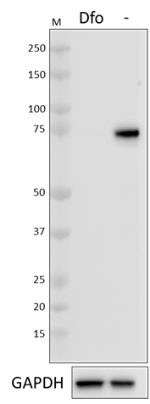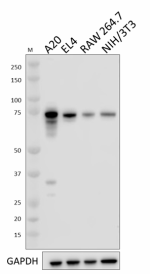- Clone
- 3F5G12G9 (See other available formats)
- Regulatory Status
- RUO
- Other Names
- F-Box And Leucine Rich Repeat Protein 5, F-Box/LRR-Repeat Protein 5, F-Box Protein FBL4/FBL5
- Isotype
- Mouse IgG2b, κ
- Ave. Rating
- Submit a Review
- Product Citations
- publications

-

Total cell lysates (15 µg protein) from NIH/3T3 cells treated with the iron chelator desferal (Dfo) for 6 hours or untreated (-) were resolved by 4-12% Bis-Tris gel electrophoresis, transferred to a PVDF membrane, and probed with 1.0 µg/mL (1:500 dilution) of purified anti-FBXL5 antibody (clone 3F5G12G9). Proteins were visualized by chemiluminescence detection using HRP goat anti-mouse IgG (Cat. No. 405306). Direct-Blot™ HRP anti-GAPDH antibody (Cat. No. 649203) was used as a loading control (lower) at a 1:20000 dilution. Lane M: Molecular weight marker. -

Total cell lysates (15 µg protein) from the indicated cell lines were resolved by 4-12% Bis-Tris gel electrophoresis, transferred to a PVDF membrane, and probed with 1.0 µg/mL (1:500 dilution) of purified anti-FBXL5 antibody (clone 3F5G12G9). Proteins were visualized by chemiluminescence detection using HRP goat anti-mouse IgG (Cat. No. 405306). Direct-Blot™ HRP anti-GAPDH antibody (Cat. No. 649203) was used as a loading control (lower) at a 1:20000 dilution. Lane M: Molecular weight marker.
| Cat # | Size | Price | Quantity Check Availability | Save | ||
|---|---|---|---|---|---|---|
| 672703 | 25 µg | 101 CHF | ||||
| 672704 | 100 µg | 253 CHF | ||||
In metazoans, iron homeostasis is mediated at the systemic and cellular levels by the RNA-binding iron regulatory proteins IRP1 and IRP2.Under conditions where cellular iron is limiting, IRP1 and IRP2 stabilize the mRNA of genes involved in iron acquisition and mobilization and translationally repress genes involved in iron storage and export. Under iron replete conditions, both IRPs are inactivated: IRP1 acquires an Fe-S cluster that inhibits RNA-binding activity, while IRP2 is targeted for proteasomal-mediated degradation by the E3 ubiquitin ligase FBXL5. Under iron-replete conditions Fe-S cluster biogenesis is disrupted, FBXL5 will also target IRP1 for degradation.
FBXL5, or F-box and leucine-rich repeat protein 5 (FBXL5), is the E3 ubiquitin ligase component of the SCFFBXL5 complex. The complex contains SKP1, Cullin-1, RBX1, and FBXL5. When cytosolic iron is replete, FBXL5 recruits IRP2 to the SCF complex and promotes its ubiquitination and subsequent degradation. FBXL5 contains a hemerythrin-like domain that senses oxygen and iron availability. This sensing mechanism is linked to the stability of the FBXL5 protein itself: when cytosolic iron is available, iron binds to the hemerythrin domain and promotes the stability of the FBXL5 protein. When iron is deficient, the FBXL5 protein lacks the iron ligand, resulting in its degradation and activation of the IRP-mediated iron starvation response.
Studies have also shown that FBXL5 can ubiquitinate and target the SNAIL1 transcription factor and disruption of this process promotes epithelial to mesenchymal transition.
Product Details
- Verified Reactivity
- Mouse
- Antibody Type
- Monoclonal
- Host Species
- Mouse
- Immunogen
- Recombinant mouse FBXL5
- Formulation
- Phosphate-buffered solution, pH 7.2, containing 0.09% sodium azide
- Preparation
- The antibody was purified by affinity chromatography.
- Concentration
- 0.5 mg/mL
- Storage & Handling
- The antibody solution should be stored undiluted between 2°C and 8°C.
- Application
-
WB - Quality tested
- Recommended Usage
-
Each lot of this antibody is quality control tested by western blotting. For western blotting, the suggested use of this reagent is 0.1 - 1.0 µg/mL. It is recommended that the reagent be titrated for optimal performance for each application.
- Application Notes
-
This clone was tested for ICC on PFA-fixed, Triton X-100-permeabilized NIH/3T3 cells. The clone produced nuclear staining that did not match the iron-responsiveness observed during western blotting. Because of this, we do not recommend using this clone for IF.
During product development testing, a protein with a slightly lower molecular weight than the target was observed during PD testing. This protein displayed a similar iron-responsiveness to the target band. It is unclear whether this band represents a minor FBXL5 degradation product or a truncated isoform.
This clone does not recognize human FBXL5. For detection of human FBXL5 by western blot, we recommend BioLegend clone 10F4H9D12 (Cat. No. 672604).
This clone has not been tested for IP. - RRID
-
AB_2832845 (BioLegend Cat. No. 672703)
AB_2832845 (BioLegend Cat. No. 672704)
Antigen Details
- Structure
- FBXL5 is a 690 amino acid protein with a predicted molecular weight of 78.56 kD.
- Distribution
-
Cytosol and nucleus/ubiquitously expressed
- Function
- Regulates iron homeostasis
- Antigen References
-
- Johnson NB, et al. 2017. J. Biol. Chem. 292:15976.
- Vinas-Castells R, et al. 2014. Nucleic Acids Res. 42:1079.
- Moroishi T, et al. 2014. J. Biol. Chem. 289:16430.
- Ruiz JC, et al. 2013. J. Biol. Chem. 288:552.
- Chollangi S, et al. 2012. J. Biol. Chem. 287:23710.
- Moroishi T, et al. 2011. Cell Metab. 14:339.
- Salahudeen AA, et al. 2009 Science. 326:722.
- Vashisht AA, et al. 2009 Science. 326:718.
- Gene ID
- 242960 View all products for this Gene ID
- UniProt
- View information about FBXL5 on UniProt.org
Related Pages & Pathways
Pages
Related FAQs
Other Formats
View All FBXL5 Reagents Request Custom Conjugation| Description | Clone | Applications |
|---|---|---|
| Purified anti-FBXL5 | 3F5G12G9 | WB |
Compare Data Across All Formats
This data display is provided for general comparisons between formats.
Your actual data may vary due to variations in samples, target cells, instruments and their settings, staining conditions, and other factors.
If you need assistance with selecting the best format contact our expert technical support team.
 Login / Register
Login / Register 









Follow Us